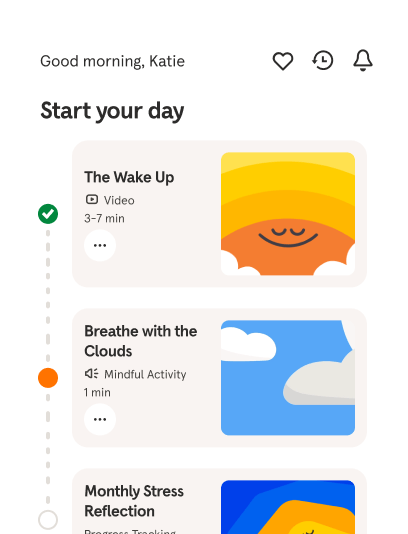Breathwork FAQs
What’s the difference between meditation and breathwork? Where do you start? Dora dives into beginners’ questions so you can practice with confidence.
Try 14 days freeBetter mental health starts with Headspace. Unrivaled expertise to make life feel a little easier, using guided meditations, mindfulness tips, focus tools, sleep support, and dedicated programs.
Try 14 days free
(bright music) This is a great question. Breathwork is the practice of consciously controlling the breath to bring about change in the mind and body. That change can be experienced on an emotional, mental, and spiritual level. Physically, as we take a deep breath, the rest and digest system signals to the brain and the rest of the body that, "Hey, we're okay, we're safe, and we can calm down." Similar to meditation, breathwork and its different techniques have been around for thousands of years. For those of you who practice yoga, you may be familiar with pranayama, which is the yogic practice of breathwork. To begin your breathwork practice, simply start by paying attention to the quality of your breath. Notice whether your breath is long or short, deep or shallow. This can be a great place to start. So pay attention to how you breathe throughout your day and then begin to incorporate different beginner practices. By becoming aware of our breath, we can actually become more aware of our minds and bodies in that process since they're all connected. In the Headspace app, check out the breathe meditation in the Meditate tab or the deep breathing practice that you can do before bed in the Sleep section. My personal favorites are the breathing animations that you can follow along with in the Focus tab. When I first started doing breathwork, I would, and still do, begin my meditation practice with deep breathing or alternate nostril breathing. And this is one way that you can incorporate breathwork into your practice, if you'd like. It's important to create a good foundational practice of being able to breathe into your stomach. So also practice this if this is something that you're new to. The truth is we're always breathing. But with breathwork, we're intentionally working with the breath to experience a sense of relaxation and calm in the mind and body. If we can practice becoming aware of our breath, then maybe even slowing it down or breathing more deeply, this is one thing that we can learn to control when everything around us feels out of control. (light music) I like to think of breathwork as a more active form of meditation, where we're moving past the mind and connecting deeply to the body, utilizing the breath. Breathwork requires a different kind of effort than meditation. We're consciously changing the way that we breathe to feel a greater sense of balance and calm in the mind and body, or also to feel more energized and alert. Since we're altering the chemistry in the body by increasing or decreasing our inhales and exhales, there's bound to be more bodily sensations that can arise while practicing breathwork. Like tingling in the hands and toes, slowing down of our heart rate, or changes in body temperature. Sometimes the areas of the body that tend to hold more tension can either tighten or relax, depending on what exercise we're doing. This is nothing...
Details
About your teachers
 Andy PuddicomeHeadspace Co-founderMore about Andy
Andy PuddicomeHeadspace Co-founderMore about AndyA former Buddhist monk, Andy has guided people in meditation and mindfulness for 20 years. In his mission to make these practices accessible to all, he co-created the Headspace app in 2010.
 Eve Lewis PrietoHeadspace Director of MeditationMore about Eve
Eve Lewis PrietoHeadspace Director of MeditationMore about EveEve is a mindfulness teacher, overseeing Headspace’s meditation curriculum. She is passionate about sharing meditation to help others feel less stressed and experience more compassion in their lives.
 Dora KamauMeditation TeacherMore about Dora
Dora KamauMeditation TeacherMore about DoraAs a meditation teacher, Dora encourages others to live, breathe, and be with the fullness of their experiences. She loves meditation’s power to create community and bring clarity to people’s minds.
 Kessonga GiscombeMeditation TeacherMore about Kessonga
Kessonga GiscombeMeditation TeacherMore about KessongaKessonga has been an acupuncturists, therapist, and meditation teacher, working to bring mindfulness to the diverse populations of the world.
 Rosie AcostaMeditation TeacherMore about Rosie
Rosie AcostaMeditation TeacherMore about RosieRosie Acosta has studied yoga and mindfulness for more than 20 years and taught for over a decade. Rosie’s mission is to help others overcome adversity and experience radical love.

Your lifelong guide to better mental health
Stress, sleep, and all the challenging emotions — care for your mind with the everyday mental health app that's shown to make a difference.
Try 14 days free
Look after your mind
Proven guided meditations and programs to help you stress less, sleep more soundly, and better navigate life’s challenges

Science-backed
Studies show that using Headspace for 30 days can reduce stress, increase resilience, and improve overall well-being

Explore 1000+ expert-led exercises
Access our library of meditations, breathing exercises, and guidance videos for stress, sleep, focus, everyday anxiety , parenting, and more.




Members are enjoying happier and healthier lives
- © 2025 Headspace Inc.
- Terms & conditions
- Privacy policy
- Consumer Health Data
- Your privacy choices
- CA Privacy Notice


